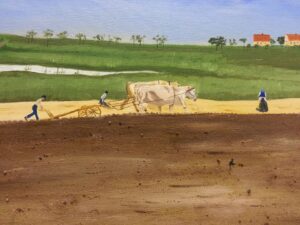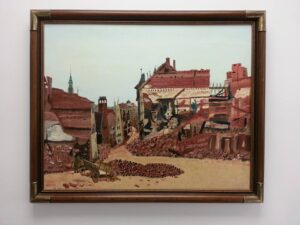 In December 2015 the Marshall Foundation acquired thirty-nine acrylic paintings from James Work of Katy, Texas, who painted scenes from his time in Germany during and after World War II. Using photos taken in 1946 and from a return visit in 1986, he painted “before and after” scenes of Germany, illustrating the results of Marshall Plan aid.
In December 2015 the Marshall Foundation acquired thirty-nine acrylic paintings from James Work of Katy, Texas, who painted scenes from his time in Germany during and after World War II. Using photos taken in 1946 and from a return visit in 1986, he painted “before and after” scenes of Germany, illustrating the results of Marshall Plan aid.
Eighteen year old Virginian Jim Work left for Europe in April 1945 on the USS Mount Vernon and as part of a replacement depot of troops. During his time in Europe Pvt. Work took pictures of his fellow soldiers and his adventures on their days off. His pictures revealed the devastation that the European countryside experienced from the war as well as the resilience of the soldiers and civilians throughout the continent.
 In the spring of 1946 he was transferred to the 301st Signal Battalion as part of the European Theater Signal School for radio repair training. His unit was billeted in Neuendettelsau which was twenty miles south of Nuremberg during the time that the military tribunals were taking place. On the weekends, he would travel and explore, taking pictures of the recovering city of Nuremberg and the surrounding countryside. His tour of duty ended in Heidelberg where he had been responsible for operating and maintaining a radio relay station on a mountain used to transmit messages between the Third Army and other headquarters.
In the spring of 1946 he was transferred to the 301st Signal Battalion as part of the European Theater Signal School for radio repair training. His unit was billeted in Neuendettelsau which was twenty miles south of Nuremberg during the time that the military tribunals were taking place. On the weekends, he would travel and explore, taking pictures of the recovering city of Nuremberg and the surrounding countryside. His tour of duty ended in Heidelberg where he had been responsible for operating and maintaining a radio relay station on a mountain used to transmit messages between the Third Army and other headquarters.
After the war Work reenlisted in the U.S. Army Reserve and enrolled at the Virginia Military Institute. He graduated in the spring of 1950 with a B.S. Degree in Electrical Engineering and was commissioned as a 2nd Lieutenant in the U.S. Army Reserve. In 1951, he married Arlene Hall. The couple traveled back to Europe in 1986 and saw the effect the Marshall Plan had in the war-torn country he’d left forty years prior. Before his return trip Work had taken painting lessons and began to chronicle his experiences in places he had been stationed.
The Marshall Plan assisted in the rebuilding of the physical, economic, and agricultural parts of Europe as well as preserving its cultural heritage. While Work was in Europe, he saw ruins rebuilt, and battlefields turned into acres of wheat and grains. The businesses and arts centers that had struggled to survive were booming with business and patrons. The Marshall plan had succeeded in offering Europeans hope for the future.
This Week’s Guest Blogger: Kaytlyn Dewey
| Kaytlyn Dewey served as a museum intern at the Marshall Foundation and assisted the Director of Museum Operations with collection accession and exhibition installation. She graduated in 2016 from Southern Virginia University with a Bachelor of Arts in History. Kaytlyn is also a member of Phi Alpha Theta, the national history honors society, and served as an Education Outreach intern with the Mesa Arts Center and as a teacher with the International Language Program. |
